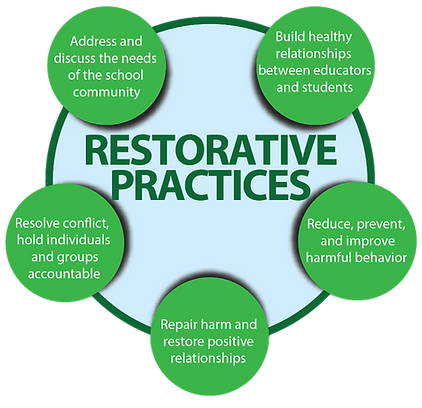
DISCOVER RESTORATIVE
BEST PRACTICES
Restorative practices employ equity and build school/classroom communities in order to create environments where students feel belonging and safety, thereby making it easier for them to learn both academically and social/emotionally. When things go wrong, rather than removing or merely punishing students, these community relationships are levied to right wrongs, provide resources, repair broken relationships and, where punishment must be levied, re-integrate students back into the school community.
Restorative practices cultivate and tend to our human need to belong and feel valued (Maslow). The practices are increasingly being applied in individual schools and school districts to improve school climate and culture, increase prosocial youth behavior, decrease rule violations and increase success rates for students. Restorative practices are processes that meet SEL and academic needs as they proactively build a sense of community in classrooms. These practices subsequently address conflict and wrongdoing by restoring the relationships that were proactively built. The practices improve relationships between students, between students and educators, and between educators, whose behavior often serves as a role model for students. Restorative practices allow each member of the school community to develop and implement a school’s adopted core values.
Additionally, restorative practices support the Common Core Anchor Standards in Speaking and Listening by developing and enhancing students’ skills in collaboration, cooperation, agreeing and disagreeing. Cultivating these skills is required if the Common Core is going to be delivered the way it was designed to be delivered.

Traditional Discipline vs Restorative Discipline
Research shows that exclusionary discipline – isolating students in or out of class and school - is harmful to developing brains, and promotes antisocial behaviors/affiliations. It is common sense that we need students to be in school and we need school to be safe and productive for everyone.
What is a Restorative Best Practices Approach
Restorative practices are time tested, solution-focused, high support and high rigor alternatives to isolating or excluding students in or from their educational setting.
The work keeps students in school and class by cultivating their sense of belonging and dignity through proactive community building and equitable responses to misbehavior that support them to repair harm and restore the relationships damaged by their actions. The use of restorative practices has been proven to decrease antisocial behavior, reduce the need for disciplinary actions, increase perceived safety, and increase academic achievement campus-wide.

We work to support adults in schools in unlearning some of the ways that we were disciplined in school and to teach teachers, staff and school administrators to listen, speak, ask questions and respond to challenging behavior in ways that preserve everyone’s dignity, and that hold students accountable with fair and consistent discipline, support and care.
Restorative practices is not another doing, it is a way of being.
Be the Difference
Contact us and find out how to make a meaningful change in the fabric of education at your site